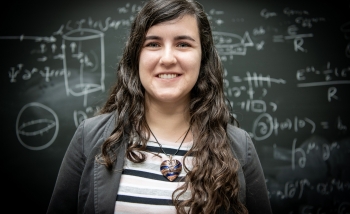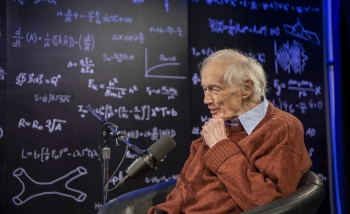Luis Lehner was only six years old, but he can still remember the books that covered his father’s desk that fateful day. Bones. Sinew. Organs. His father was a surgeon preparing for an operation, and Lehner did not like what he saw. Not one bit.
But he was a curious child – always opening cupboards at friends’ houses to find out what lay out of sight – and he was clever. So, in a family full of doctors and dentists, Lehner chose one of the few fields considered even harder than medicine. He became a physicist.
“I’m the black sheep,” laughs the 47-year-old Argentinian, who is deputy faculty chair at Perimeter Institute. If that’s the case, then he’s earning himself quite the pedigree.
Scientists know that Einstein’s theory of curved spacetime – general relativity – breaks down in extreme areas, and that such breaks might leave imprints inside black holes. As a specialist in general relativity, Lehner uses advanced mathematics and numerics to push the theory to its limits, and hopefully find the cracks that lead to new physics.
Gravity is at the forefront of physics now, but that wasn’t always the case. When Lehner was starting university in the 1990s, general relativity was considered by many scientists to be something of an outdated area.
But Lehner was in Argentina, and there was little hope his country could ever afford to build the large science experiments that were driving research elsewhere. That freed people up to pursue questions most first-world researchers ignored.
“In developing countries, we are not necessarily tied to what’s in fashion or what’s in vogue,” he says. “You have to embrace the feeling of doing research for research’s sake. If there is a good question, even though you may not answer it in 20 years, it is still a valid question, so let’s keep pursuing it.”
It’s somewhat ironic, then, that almost 20 years after he chose to study gravity, work by Lehner and others is helping to shape one of the greatest scientific achievements so far this century.
When the Laser Interferometer Gravitational-Wave Observatory (LIGO) collaboration turned on the world’s largest hearing aid and started scanning the sky for gravitational waves, they had an idea of what to listen for thanks to theoretical predictions. The tell-tale chirp made by two black holes merging – heard in 2015 and made public in 2016 – matched predictions perfectly, and marked the dawn of a new era in cosmology research.
It was a hugely exciting time for gravity researchers; for Lehner, it is just the beginning. His current work is pushing on three fronts: the emerging area of gravitational wave astronomy; the links between strong gravity and possible quantum theories of gravity; and the dynamic regions of neutron stars – ultradense objects that pack the mass of the sun into a sphere 15 kilometres across.
Unlike black holes, which have great mass but emit no light, neutron stars emit both gravitational waves and electromagnetic waves. These two sources of information could provide a much richer understanding of gravity in extreme places – especially, Lehner hopes, if we see two of them collide.
“Everything is going to happen!” he exclaims. “We have tremendous amounts of energy coming out in all forms, from electromagnetic waves, gravitational waves, to even particles: we’ll get neutrinos. I want to understand the problem in full. I don’t want to go to dinner and only have the first course. This is a full dinner with entree, main course, dessert. I’ll go for everything.”
Further exploration
About PI
Perimeter Institute is the world’s largest research hub devoted to theoretical physics. The independent Institute was founded in 1999 to foster breakthroughs in the fundamental understanding of our universe, from the smallest particles to the entire cosmos. Research at Perimeter is motivated by the understanding that fundamental science advances human knowledge and catalyzes innovation, and that today’s theoretical physics is tomorrow’s technology. Located in the Region of Waterloo, the not-for-profit Institute is a unique public-private endeavour, including the Governments of Ontario and Canada, that enables cutting-edge research, trains the next generation of scientific pioneers, and shares the power of physics through award-winning educational outreach and public engagement.
You might be interested in



Spiralling light from M87’s supermassive black hole reveals strong magnetic fields
November 8, 2023